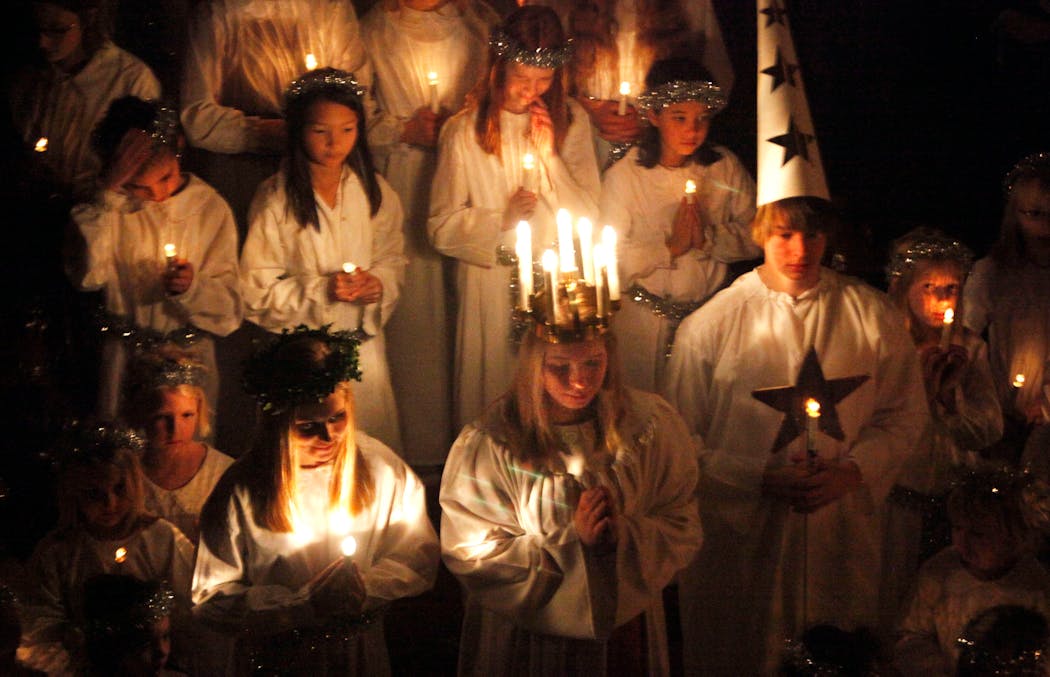Is Minnesota actually more German than Scandinavian?
Listen and subscribe to our podcast: Via Apple Podcasts | Spotify | Stitcher
Ya betcha Minnesota is known for its Scandinavian heritage.
From Midsommer festivals to St. Lucia Day celebrations and lutefisk dinners, Minnesotans like to celebrate their roots. That got Tim Mengelkoch wondering about his roots.
"Why is Scandinavian ancestry always mentioned so frequently when people of German descent make up a larger percentage of our population?" asked the 73-year-old, who lives in Bemidji, and, notes that his last name is indeed German.
"Over the years I have always noticed stories about Swedish and Norwegian celebrations and events such as the Midsummer Festival but almost nothing about German events."
He posed the question to Curious Minnesota, our community reporting initiative fueled by questions from readers. His question was picked to investiagate after it was the top vote-getter in a voting round.
First, were his numbers correct? In the most recent American Community Survey, 45% of Minnesotans said they had ancestors from either Norway, Denmark or Sweden compared to 55% who said they had ancestors from Germany. Score 1 for Mengelkoch.
But has it always been that way? In 1890, the U.S. Census didn't ask about ancestry. But it did collect information about the people who lived in Minnesota but had been born in another country. That data shows that 25% of the state's foreign-born population was born in Germany, compared to 46% from either Sweden, Norway or Denmark. No other state had a higher share of Scandinavian-born people. Score 1 for Minnesota's Scandinavian settlers.
Jeana Anderson, executive director of the Germanic-American Institute in St. Paul, agrees that Germans can often get lost in Minnesota's Viking heritage. "There's a lot of misinformation out there about how strong the German community is" here, she said. The reason she has often heard, is that, especially after the war, "the focus was on assimilation … and not to be so connected to our German identity."
As for the festivals, Ingrid Nyholm-Lange, director of experience at the American Swedish Institute in Minneapolis, said Germany is one country, while Scandinavia includes three separate countries (five if you use the broader Nordic term, which includes Finland and Iceland), each with their own independence day celebrations and holiday traditions. That can add up to a lot of festivals.
Both cultural centers are seeing a resurgence in interest in recent years. Anderson said GAI continues to expand, offering community education, a full-preschool and 32 German classes at all different levels. "There's this whole boom of German language education," she said.
There are several reasons for this, said Claudia Aurand, director of Language Services for GAI, including a general trend toward globalization and Germany as a popular destination for business and leisure travel. Also all those 2nd and 3rd generation German descendants in Minnesota are "rediscovering" their heritage and want to learn the language.
ASI, which has been around for 90 years and is often mentioned as a "must do" stop in travel guides to the Twin Cities with its castle home in south Minneapolis, continues to grow as it both celebrates Swedish culture and shares it, said Nyholm-Lange.
Membership is at a record high. The number of Nordic cooking and handicraft classes it offers has more than doubled in the past fiscal year — to 165 courses. Among the offerings: working with birch bark, weaving wheat into love tokens and a seafood cooking class that teaches salmon quiche, the "iconic open-faced shrimp sandwich, and classic open-faced herring sandwiches."
It also uses its mansion headquarters, donated by Swedish immigrant Swan Turnblad and his family in 1929, in popular events: Kids at the Castle and Cocktails at the Castle.
But perhaps its dominance can be summed up in budgets alone. In its most recent federal nonprofit filing it listed assets of about $31 million, the bulk of that from that land and buildings. GAI's? About $750,000.
Game, set and match to the Swedes.
Data editor MaryJo Webster contributed to this report. Karen Margrethe Lundegaard's grandparents immigrated from Denmark, but she is married to a man of German descent.
---
If you'd like to submit a Curious Minnesota question, fill out the form below:
Read more Curious Minnesota stories:
Why do we have water towers and what do they do?
Who are all the people on sidelines during Vikings games?
Why isn't it a crime to punch someone in the face in pro hockey?
Why does the Stone Arch Bridge cross the river at such an odd angle?
How did Minnesota become the Gopher State?
Are roundabouts really safer than traditional intersections?
Why do so many Fortune 500 companies call Minnesota home?



